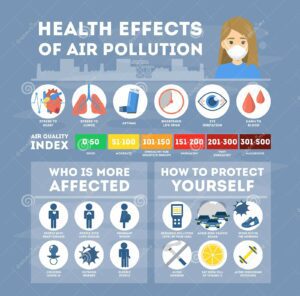Health as the focus of air pollution policy
#GS-02 Healthcare, #GS-03 Pollution
For Mains:
The negative effects of Air Pollution:
- The effects of exposure to bad air are felt in every organ of the body, and most deeply by the vulnerable in society, i.e., children, the elderly, pregnant women, and those with pre-existing health conditions.
- In India, in 2019, 17.8% of all deaths and 11.5% of respiratory, cardiovascular and other related diseases are attributable to high exposure to pollution.
What are the concerns regarding Pollution laws:
- Health is termed as the raison d’etre of environmental legislation as clearly laid out in the statement of objects and reasons of India’s key environmental laws.
- However, if we examine the constitution of our environmental regulators, expert groups and decision-making entities that define and translate those laws into air pollution policy, health expertise is glaring in its absence.
- An examination of even the most recently constituted institution, the Commission for Air Quality Management, reveals a lack of any health representation.
- Recent papers published by the Centre for Policy Research also reveal that health sector representatives comprise less than 5% of the membership of State Pollution Control Boards.
- Air pollution policy is created and implemented under an insufficient understanding of health among policymakers.
- So far, Indian air pollution policy has at best treated health as merely one of the several equally relevant facets in decision-making.
What needs to be done:
- Health and epidemiological evidence need to drive our determination to achieve substantial health benefits from clean air targets.
- The only effort till date in India, which has viewed air pollution through this lens, is the Ministry of Health’s Steering Committee on Air Pollution, which took an exposure-centered view to policy.
- It did this by prioritising interventions that contributed the most to reducing exposure and thereby providing health benefits.
- It also brought to light the local and global epidemiological evidence on the harmful effects of air pollution, and defined policy measures aligned with that science.
- As India is in the process of revising its ambient air quality standards (NAAQS), it would do well to learn from this ground-breaking effort.
- The final step would require a radical rethinking of the way we design policy from the ground up.
- Whether it is stubble burning or thermal power plant emissions, decisions are made without any consideration of their potential second and third order effects, especially on health.





